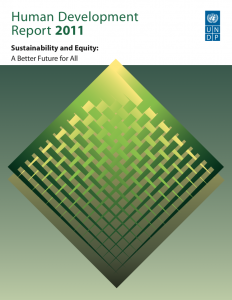Resource Title
Human Development Report 2011: Sustainability and Equity – A Better Future for All
Summary
The 2011 Human Development Report (HDR) themed on ‘Sustainability and Equity’, argues that sustainability and equity (e.g. social justice) must—and can—be addressed simultaneously in order to achieve a fair, inclusive and sustainable future.
Sustainability is not exclusively or even primarily an environmental issue. It is about how we choose to live our lives, with an awareness that everything we do has consequences for the 7 billion of us here today, as well as for the billions more who will follow, for centuries to come.
Resource Details
Description
Spread over five chapters, the 2011 report integrates previous learning from older HDRs and includes the new statistical measures added to the human development indices: the Inequality-adjusted Human Development Index, the Gender Inequality Index and the Multidimensional Poverty Index. At 185 pages in length, the report examines social factors not always associated with environmental sustainability.
The report highlights that despite the human development progress of recent years, income distribution has worsened, grave gender imbalances still persist, and accelerating environmental destruction puts a “double burden of deprivation” on the poorest households and communities. The report notes that half of all malnutrition worldwide is attributable to environmental factors, such as water pollution and drought-driven scarcity, perpetuating a vicious cycle of impoverishment and ecological damage.
Typical of the HDRs, the 2011 report contains many data sheets of statistical information on development. The 2011 report is no exception. Scenarios projecting impacts of environmental risks to human development are explored (through to 2050). Country trends, indicators and statistics are provided on the following:
- Human Development Index and its components
- Human Development Index trends, 1980–2011
- Inequality-adjusted Human Development Index
- Gender Inequality Index and related indicators
- Multidimensional Poverty Index
- Environmental sustainability
- Human development effects of environmental threats
- Perceptions about well-being and the environment
- Education and health
- Population and economy
The annual Human Development Reports have been published since 1990 and document, measure and analyse the progress in human development over recent decades. Earlier HDRs are available free of charge at www.hdr.undp.org, including full texts and summaries in major UN languages, summaries of consultations and network discussions, the Human Development Research Paper Series and HDR news bulletins and other public information materials. Also available are statistical indicators, other data tools, interactive maps, country fact sheets and additional information associated with the HDRs.
Big Ideas in this Resource
- Sustainability is inextricably linked to equity—to questions of fairness and social justice and of greater access to a better quality of life. Continuing failure to reduce the grave environmental risks and deepening inequalities threatens to slow decades of sustained progress by the world’s poor majority—and even to reverse the global convergence in human development.
- Power imbalances and gender inequalities at the national level are linked to reduced access to clean water and improved sanitation, land degradation and illness and death due to air pollution, amplifying the effects associated with income disparities. Gender inequalities also interact with environmental outcomes and make them worse. At the global level governance arrangements often weaken the voices of developing countries and exclude marginalized groups.
- Investments that improve equity—for example, in access to renewable energy, water and sanitation, and reproductive healthcare—could advance both sustainability and human development. Stronger accountability and democratic processes can also improve outcomes. Successful approaches rely on community management, broadly inclusive institutions and attention to disadvantaged groups.
- Beyond the Millennium Development Goals, the world needs a development framework that reflects equity and sustainability. This Report shows that approaches that integrate equity into policies and programmes and that empower people to bring about change in the legal and political arenas hold enormous promise.
- The financing needed for development are many times greater than current official development assistance. Financing flows need to be channelled towards the critical challenges of unsustainability and inequity. While market mechanisms and private funding will be vital, they must be supported and leveraged by proactive public investment.
Other Information
Statistical tables, individual chapters, press releases and illustrations can be downloaded for free at hdr.undp.org/en/reports/global/hdr2011/download/
Available from:
Download Human Development Report 2011 PDF or access individual chapters and statistical notes separately at hdr.undp.org/en/reports/global/hdr2011/

